Salazar Pushes Ivanpah and Other Solar, Wind Projects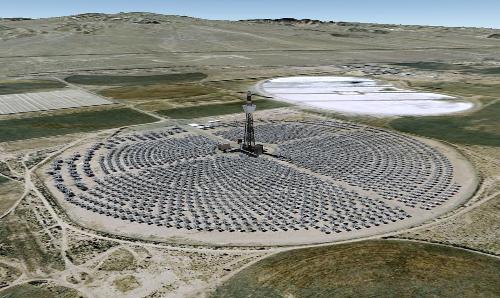

^Solar 1 (later redesigned as Solar 2) in Daggett, California. It was so unprofitable and inefficient that the plant is now shut down and is being dismantled. The mirror array in this image covers only 126 acres (of disturbed private farm land). The Ivanpah solar project would scale this design up to cover 4,000 acres of pristine desert on public land. (Image courtesy GoogleEarth)
November 5, 2009 -
Secretary of the Interior Ken Salazar today detailed several California renewable energy projects that are on a fast track in the desert.
“Under President Obama's leadership, we have entered a new energy frontier," Salazar said. “By putting these renewable energy projects on a fast track, we are managing our public lands not just for conventional energy development but also for environmentally responsible renewable energy production that will power our clean energy future.”
Fast-track projects are those where the companies involved have demonstrated to the Bureau of Land Management (BLM) that they have made sufficient progress to formally start the environmental review and public participation process. These projects are advanced enough in the permitting process that they could potentially be cleared for approval by December 2010, thus making them eligible for economic stimulus funding under the American Recovery and Reinvestment Act of 2009. We note that many of these companies are foreign-owned, such as Solar Millennium, a subsidiary of a German company. All renewable energy projects proposed for BLM-managed lands are supposed to receive full environmental reviews required by the National Environmental Protection Act (NEPA). But we have discovered that fast-tracking means the timelines and deadlines for this review process are compressed, as in BrightSource's Ivanpah Solar Electric Generating System proposal.
The Department of Interior news release states: "The draft environmental impact statement for the BrightSource solar energy development concluded the project could proceed without harming federally and state protected plants and wildlife under certain conditions." This is simply not supported by the evidence in this very document. Two rare plants are admitted to be "unmitigatable" -- the project will destroy these populations. Protected Desert tortoises, Burrowing owls, nesting and migratory birds, potential Gila monsters, Badgers, and Bighorn sheep will have 4,000 acres of habitat removed and even potential direct kills from construction activities or indirect deaths from ill-conceived translocation projects that have failed in the case of the Fort Irwin tortoise. 4,000 acres of biologically rich and diverse old-growth Mojave Desert yucca and cactus habitat will be graded, roads built all over it, vegetation mowed down to one foot, giant barrel cacti dug up and moved, and the whole area surrounded with an 8-foot high barbwire fence that will exclude movement of larger animals through it (as well as excluding the public from their land held in trust by the BLM). We are amazed this is considered "not harmful."
The news release goes on to say that the statement "recommends that the developer be required to purchase and manage up to 12,000 acres of habitat for the desert tortoise because the project would remove about 4,000 acres of habitat used by the protected species." This sounds good, but is misleading.
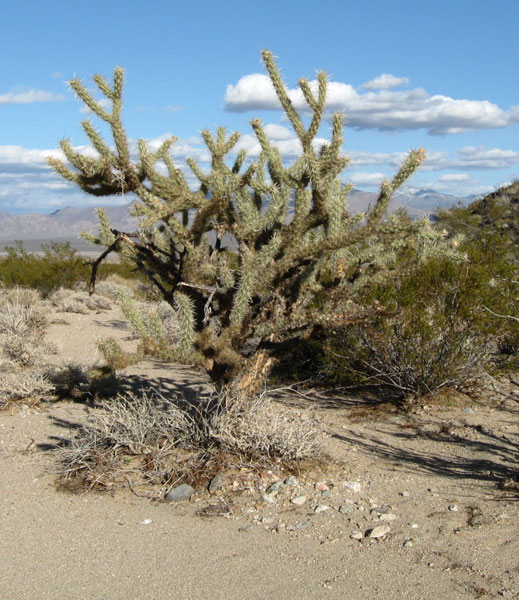 In the IVANPAH SOLAR ELECTRIC GENERATING SYSTEMS (ISEGS) FINAL STAFF ASSESSMENT, DRAFT ENVIRONMENTAL IMPACT ASSESSMENT, we read: "To fully mitigate for habitat loss and potential take of desert tortoise, the project owner shall provide compensatory mitigation at a 3:1 ratio for impacts to 4,073 acres or the area disturbed by the final project footprint. At least two thirds of the 3:1 mitigation to satisfy the Energy Commission’s Complementary Mitigation Measures shall be achieved by acquisition, in fee title or in easement, of no less than 8,146 acres of land suitable for desert tortoise." (page 6.2-120, >>here)
In the IVANPAH SOLAR ELECTRIC GENERATING SYSTEMS (ISEGS) FINAL STAFF ASSESSMENT, DRAFT ENVIRONMENTAL IMPACT ASSESSMENT, we read: "To fully mitigate for habitat loss and potential take of desert tortoise, the project owner shall provide compensatory mitigation at a 3:1 ratio for impacts to 4,073 acres or the area disturbed by the final project footprint. At least two thirds of the 3:1 mitigation to satisfy the Energy Commission’s Complementary Mitigation Measures shall be achieved by acquisition, in fee title or in easement, of no less than 8,146 acres of land suitable for desert tortoise." (page 6.2-120, >>here)
In other words the actual land acquired as mitigation will probably only be 2:1, with the other third provided as funds, usually used by the Department of Fish and Game to manage or "improve" the acquired land. In addition, the acquired land will only be chosen to satisfy Desert tortoise habitat requirements, and not specifically to mitigate for the many rare plants, Burrowing owls, Gila Monster, Bighorn sheep, and other species (a common practice but not ecologically sound).
We will be working to see that this project does not happen at all in this beautiful valley.
(Source: Department of Interior News http://www.doi.gov/news/09_News_Releases/110509b.html)
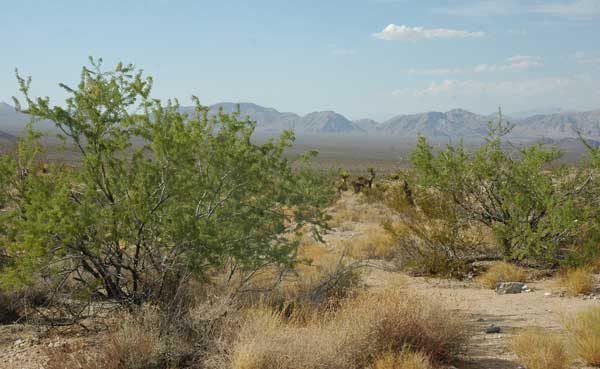
^Ivanpah Valley Catclaw acacias in summer.
Fast-tracked Solar and Wind Projects in the California Desert
BrightSource Ivanpah Solar Electric Generation System
- In Ivanpah Valley, about 5 miles southwest of Primm, Nevada, in San Bernardino County, California.
- 400-Megawatt (MW) solar thermal project would incorporate seven 459-foot tall power towers and 214,000 heliostats (each holding two flat mirrors).
- The three solar thermal power plants would interconnect to the Southern Calif. Edison grid through upgrades to the transmission line passing through the site and a new substation. It would serve utilities owned by PG&E Corp. (PCG) and Edison International (EIX).
- The project’s power plants would share an administrative complex/construction logistics area on approximately 4,073 acres of public land.
- BrightSource Energy is a privately held company with operations in the U.S., Israel, and Australia.
- See our story >>here.
- California Energy Commission (CEC) page: http://www.energy.ca.gov/sitingcases/ivanpah/index.html
Solar Millennium (Blythe)
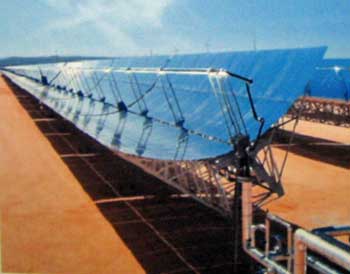
- The proposed Blythe Solar Power Project is a thermal parabolic trough electrical generating facility capable of generating 986 MW of renewable power.
- The proposed Blythe facility footprint will be approximately 6,300 acres within a proposed 9,560- acre permanent right-of-way (ROW). No privately owned land is involved.
- The project site is in Riverside County, California, approximately eight miles west of Blythe, California, in the Colorado Desert of Chuckwalla Valley.
- The proposed site is adjacent to the I-10 transmission corridor, a major energy transmission corridor in southern California.
- CEC page: http://www.energy.ca.gov/sitingcases/solar_millennium_blythe/index.html
Solar Millennium (Palen)
- The project site is in Riverside County, California, approximately 10 miles east of Desert Center in Chuckwalla Valley. Generally, the proposed site is immediately adjacent to the I-10 transmission corridor.
- The proposed Palen Solar Power Project is a thermal parabolic trough electrical generating facility capable of generating a maximum 484 MW of power.
- The proposed facility footprint will be approximately 3,800 acres within a proposed 5,176-acre permanent ROW. No privately owned land is involved.
- CEC page: http://www.energy.ca.gov/sitingcases/solar_millennium_palen/index.html
Solar Millennium (Ridgecrest)
- The Ridgecrest Solar Power Plant Project (RSPP) will be a dry-cooled parabolic trough solar thermal electric power generating facility. It will generate a nominal 250 MW.
- The proposed facility footprint is approximately 1,760 acres (plant will occupy approx. 1,440 acres) within a 3,920-acre proposed ROW on BLM managed land.
- The project is located 5 miles southwest of Ridgecrest, Kern County. The site is located 1-mile west of the intersection of Hwy 395 and China Lake Boulevard and primary access is from Brown Road. Brown Road bisects the project.
- CEC page: http://www.energy.ca.gov/sitingcases/solar_millennium_ridgecrest/index.html
NextEra Genesis Ford Dry Lake Solar Project
- North of I-10, near Ford Dry Lake (about 20 miles west of Blythe in Riverside County, CA).
- 250-MW project would cover 4,640 acres. Two independent thermal-power generating facilities using wet-cooled, parabolic solar troughs.
- Ties into a 230-kilovolt (kV) on-site switchyard and Blythe Energy/FPL 500-kV line, with an interconnect to the Colorado River Substation.
- NextEra Energy Resources, a Florida Power and Light Subsidiary, is currently the largest generator of solar energy in the U.S.
- CEC page: http://www.energy.ca.gov/sitingcases/genesis_solar/index.html
Stirling Energy Systems Solar Two Project
- The Stirling Energy Systems Solar Two project is a 750 MW solar generation power plant proposal to be located in the Imperial Valley, California in close proximity to El Centro.
- Project is proposed on 6,140 acres of public lands administered by BLM in the El Centro Field Office of the California Desert District, along with 360 acres of private lands.
- Technology utilized will be the Stirling Energy Systems Suncatcher solar dish.
- Cuts across the historic Anza Trail and covers Flat-tailed horned (Phrynosoma mcallii) lizard habitat.
- CEC page: http://www.energy.ca.gov/sitingcases/solartwo/index.html
Stirling Energy Solar One Project
- Solar One is a 850 MW Solar generation power plant proposal located in San Bernardino County, California in close proximity to Barstow (37 miles east).
- Project is proposed on 8,230 acres of public lands administered by BLM in the Barstow Field Office of the BLM California Desert District.
- The proposed project would include construction of one phase for a 500 MW power generation facility and a second phase for a 350 MW power plant site adjacent to the first phase.
- Technology utilized will be the Stirling Energy Systems Suncatcher solar dish.
- Proposal includes constructing a 500 kV transmission line to the Pisgah Substation owned by SCE which will need to be expanded for capacity purposes.
- See our story >>here
- CEC page: http://www.energy.ca.gov/sitingcases/solarone/index.html
NextEra First Solar Desert Sunlight
- Proposed project for a thin film technology, photo voltaic array, electrical generating facility capable of generating 550 megawatts (MW) of renewable power.
- The proposed project site is located on approximately 9,510 acres of federal land managed by the BLM. No privately owned land is involved. Update 12/2/2009: The project size had been reduced to 4,000 acres.
- The project site is in Riverside County, California, approximately 5.7 miles north of the community of Desert Center, in the Chuckwalla Valley. Desert Center is located 60 miles east of Palm Springs, CA. The proposed site is 7 miles north of the I-10 transmission corridor, a major energy transmission corridor in southern California.
- First Solar, a private entity, is the proponent of the Desert Sunlight Power Project.
- CEC page (scroll down to list): http://www.energy.ca.gov/siting/solar/index.html
Chevron Energy Systems Lucerne Valley
- Proposed CES Lucerne Valley Solar Plant is a photovoltaic solar electrical generating facility capable of generating 60 MW of renewable power.
- The proposed CES solar project site is located on approximately 516 acres of BLM managed land. Project location is eight miles east of the community of Lucerne Valley, San Bernardino Valley.
- The project would be constructed in three phases. Phase I of the project would consist of up to 180,000 photovoltaic panels with a nominal generating capacity of 20 MW. Phases II and III would consist of the same configuration as phase I for a total generating capacity of 60 MW.
- BLM page (pdf): >>here.
- Review started December 2, 2009, by the California Energy Commission, after receiving an application from SolarReserve LLC, of Santa Monica, California.
- Located in eastern Riverside County, adjacent to State Route 62. The nearest occupied residence is 15 milesnortheast of the plant. The nearest town is Parker, Arizona 32 miles east.
- Proposed 150-megawatt solar thermal facility, with central receiver tower and an integrated thermal storage system. A field of sun-tracking mirrors heliostats will reflect sunlight onto a central receiver. Liquid salt (a mixture of sodium nitrate and potassium nitrate) mixed onsitewill be circulated through tubes in the receiver, collecting the energy gathered from the sun. The heated salt is then routed to an insulated
storage tank where it can be stored with minimal energy losses. When electricity is to be generated, the hot molten salt is routed to heat exchangers, a steam generation system. The steam is then used to generate electricity in a conventional steam turbine cycle. After exiting the steam generation system, the salt is sent to the cold salt thermal storage tank and the cycle is repeated. - On about 3200 acres of private land surrounded by BLM managed lands.
- The facility's generation tie-in line will connect to a Western Area Power
Administration interconnection 10 miles southeast of the plant. Part of the
project's transmission lines will cross BLM-managed land, necessitating both
state and federal review of the facility. - See http://www.energy.ca.gov/sitingcases/ricesolar/index.html
AES Daggett Ridge Wind Project
- About 6 miles southeast of Barstow and 5 miles southwest of Daggett in San Bernardino County.
- Wind energy generating facility capable of generating 82.5 MW on approximately 1,577 acres of BLM managed land and 380 acres of private land.
- Substation, storage yard, offices, and maintenance shops would be on private land.
- AES Wind Generation is a subsidiary of AES, a global power company founded in 1981 with generation and distribution businesses across five continents.
- BLM list pdf: >>here.
Tule Wind
- Pacific Wind Development, LLC, a subsidiary of Iberdrola Renewables, has proposed to develop the Tule Wind Farm, a wind energy generating facility capable of generating 200 megawatts (MW) of renewable power.
- The proposed project site is located on approximately 15,493 acres of multiple jurisdiction land.
- The project includes turbines, access roads, electrical collector and transmission lines, a substation, meteorological towers and storage yards/operations and maintenance facilities.
- The project would be constructed in one phase.
- The Project is located in McCain Valley in eastern San Diego County, approximately 60 miles east of the city of San Diego. The closest community is Boulevard, approximately two miles south of the main project. Anza-Borrego Desert State Park lies to the east.
- KPBS news release: http://www.kpbs.org/news/2009/oct/09/energy-company-proposes-wind-project-boulevard/
Granite Mountain Wind Energy Project
- RES North America, LLC (RES) has proposed to develop the RES Granite Wind Project, a wind powered electrical generating facility capable of generating 73 MW of renewable power.
- The project will be comprised of up to 28 Siemens or similar, 2.3 MW wind turbine generators.
- The project site is located on approximately 1,968 acres of federal land managed by the BLM and 670-acres of private land in San Bernardino County, approximately 6 miles east of Apple Valley in the Granite Mountains.
- BLM page: http://www.blm.gov/ca/st/en/fo/barstow/granit_wind_energy.html
(Source: BLM http://www.blm.gov/ca/st/en/fo/cdd/alternative_energy/fast-trackfastfacts.html)
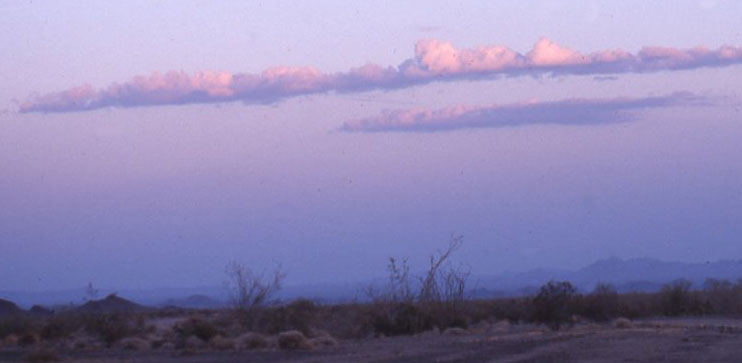
^Chuckwalla Valley, a unique area of Colorado Desert that is becoming filled with ill-placed utility-scale solar energy projects.
Western Business Roundtable Recommends Ways to Fast-Track
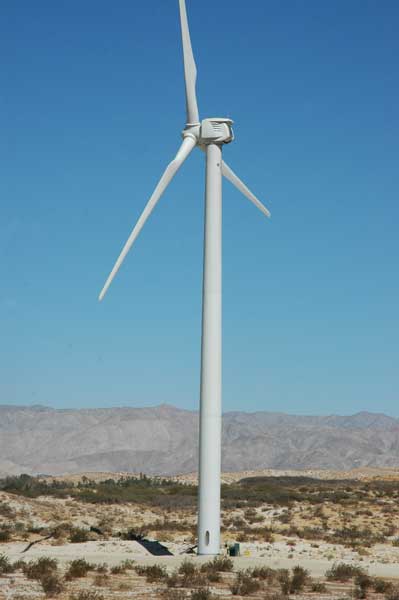 Meanwhile a group of CEOs and senior executives had their own say lobbying Congress.
Meanwhile a group of CEOs and senior executives had their own say lobbying Congress.
Jim Sims, co-founder of the Geothermal Energy Association, said “America's high-voltage transmission systems are stressed already, and have been for years. Adding a lot more of renewable power to the grid, which virtually everyone supports, is going to stress grids even further, given that renewables inject highly variable power flows on a system that wasn't’t built to handle a lot of variable flows .Moreover, as our economy begins to recover, demand for power is going to increase, and that will put further stress grids."
“The solution is to speed up government approval of transmission grid additions and upgrades and power plant proposals so we can firm up the grid and increase its ability to accept a lot more renewable generators," he said.
He said that in nearly all cases, intermittent renewables like wind need a one-to-one backup from fossil and nuclear energy facilities.
Sims identified key barriers to building more transmission:
• Political opposition and lawsuits by environmental groups against baseload power plants that are required to keep the grid energized and back-up renewable power generation.
• Political opposition and lawsuits by environmental groups and some landowners against transmission additions.
• Bureaucratic delays and outright opposition by federal land managers who fundamentally don’t want transmission lines going across the public lands they manage.
• Reluctance by state regulators to pass through to their rate base cost increases for grid additions that are being built to serve remote loads and/or additions that are designed to put relatively high-priced, intermittent renewable resources on the grid.
• Market and regulatory uncertainty created by public statements and proposed federal legislation that would impose discriminatory access to the grid in favor of power developers and/or politically favored generation technologies.
• Market and regulatory uncertainty tied to climate change policy development.
• Technical challenges to putting large amounts of intermittent power sources on the grid.
• The relatively shorter-term approach to resource planning and acquisition that industry has been forced to adopt because of all of the above factors.
(Source: Western Business Roundtable)
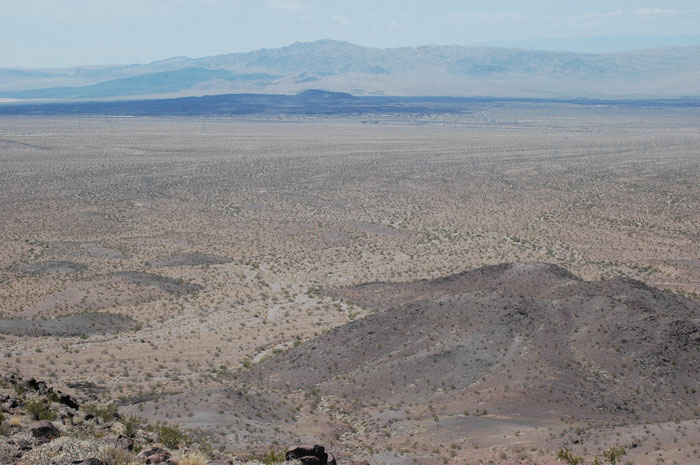
^Solar 1 project site east of Barstow, California. Pisgah Crater volcanic cone spreads black lava in the distance. View from the Cady Mountains proposed Wilderness.
HOME.....Ivanpah Solar Electric Generating System.....Chuckwalla Valley
Solar Millennium Amargosa Valley Nevada Project.....Solar 1 San Bernardino County, CA
